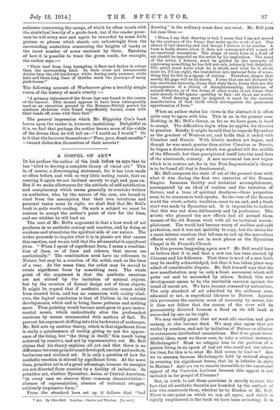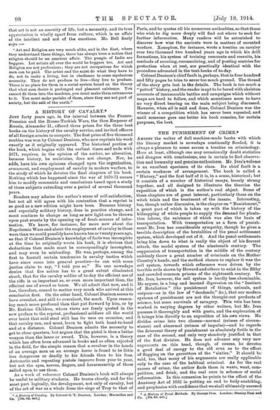A GOSPEL OF ART.•
IN his preface the author of the book before us says that be has "tried to develop a complete theory of visual art." This is, of course, a discouraging statement, for it has been made so often before, and with so very little lasting result, that on meeting it again we are inclined merely to sigh and pass on. But if we make allowances for the attitude of self-satisfaction and complacency which seems generally to overtake Writers on aesthetics, who, by the nature of the case, are bound to start from the assumption that their own intuitions and personal tastes must be right, we shall find that Mr. Bell's book is quite worth reading. On such a subject we must be content to accept the author's point of view for the time, and see whither he will lead us.
The root of Mr. Bell's argument is that a true work of art produces in us aesthetic ecstasy and emotion, and by doing so awakens and stimulates the spiritual side of our nature. The writer proceeds to inquire what it is in plastic art that causes this emotion, and we are told that the all-essential is significant form. " When I speak of significant form, I mean a combina- tion of lines, or of lines and colours, that moves me aesthetically." The combination need have no reference to Nature, but may be a creation of the artist, such as the lines of a vase. At the same time, the artist may be moved to create significant form by something seen. The whole ,point of the argument is that the aesthetic emotions are not stirred by the imitation of natural objects, but by the creation of formal design out of these objects. It might be argued that if aesthetic emotion comes solely from created form, and has no connexion with reality what- ever, the logical conclusion is that of Cubism in its extreme developments, which end in being linear patterns and nothing more. Thus painting would become analogous to pure instru- mental music, which undoubtedly stirs the profoundest emotions by means unconnected with matters of fact. To prevent his argument drifting into this backwater of arabesque, Mr. Bell sets up another theory, which is that significant form is really a quintessence of reality, giving us not the appear- ance of the thing, but "the thing in itself," this result being achieved by creative, and not by representative, art. Mr. Bell claims that his theory explains all art, and that there is no difference between primitive and developed, ancient and modern, barbarous and civilized art. It is only a question of how far aesthetic emotion is stirred by significant form. At the same time, primitive art is at a great advantage, because its energies are not diverted from creation by a facility of imitation. In primitive art, whether Byzantine, Asian, or Central American, " in every case we observe three common characteristics— absence of representation, absence of technical swagger, sublimely impressive form."
From the standard here set up it follows that "bad
• Art. By Clive BelL London: Chatto and Windua. [5s. net.]
drawing" in the ordinary sense does not exist. Mr. Bell puts his case thus
When I say that drawing is bad, I mean that I am not moved by the contours of the forms that make up the work of art. The causes of bad drawing and bad design I believe to be similar. A form is badly drawn when it does not correspond with a part of an emotional conception. The shape of every form in a work of art should be imposed on the artist by his inspiration. The hand of the artist, I believe, must be guided by the necessity of expressing something he has felt not only intensely but definitely. The artist must know what he is about, and what he is about must be, if I am right, the translation into material form of some- thing that he felt in a spasm of ecstasy. Therefore, shapes that merely fill gaps will be ill-drawn. Forms that are not dictated by any emotional necessity, forms that state facts, forms that are the consequences of a theory of draughtsmanship, imitations of natural objects, or of the forms of other works of art, forms that exist merely to fill spaces—padding in fact—all these are worth- less. Good drawing must be inspired, it must be the natural manifestation of that thrill which accompanies the passionate apprehension of form."
When an author states his views in the abstract it is often quite easy to agree with him. This is so in the present case. Nothing in Mr. Bell's theory, as far as we have gone, is hard to accept. The difficulties begin when be applies his theories to practice. Briefly, it might be said that he regards Byzantine as the greatest of Western art, and holds that it ended with Cimabue and Duccio. With Giotto modern art began, and though he was much greater than either Cimabue or Duccio, he began a downward slope which was gradual till the middle of the fifteenth, but then precipitated itself into the mud flats of the nineteenth, century. A new movement has now begun which is to restore art, for in the Post-Impressionist's theory is to be found all that is fundamental.
Mr. Bell compares the state of art at the present time with what it was during the first two centuries of the Roman Empire. Immense facility and technical accomplishment, accompanied by an ideal of realism and the imitation of Nature, and a time of spiritual deadness—these properties
seem to be common to both epochs. In the case of the Roman world the whole artistic tradition came to an end, and a fresh
start was made by Byzantine art. It is impossible to believe that this was not done deliberately and by preference. The artists who planned the new effects had all around them masses of the old Roman work with all its technical accom- plishment. The world had become weary of soulless and cold perfection, and it was not inability to copy, but the desire for a more intense emotion, that led men to call up the marvellous effects which we still see in such places as the Byzantine Chapel in St. Praxed's Church.
Is this process happening again now ? Mr. Bell would have us believe that it is, and that a new era has been started by Cezanne and his followers. That there is need of a new birth may be readily acknowledged, but that it has taken place may admit of considerable dispute. Mr. Bell himself says that the new manifestation may be only a fresh movement which will peter out and be succeeded by others. Indeed, this new development seems to be the inevitable reaction against the trend of recent art. We have become obsessed by naturalism. The only standard of art admitted by the ordinary man, educated or not, is superficial likeness to Nature. Against this perversion the reaction must of necessity be severe, but it does not follow that the course of the river will be permanently diverted because a flood on its left bank is succeeded by one on its right.
We may readily grant that art must stir emotion and give ecstasy, or else become dead. We may also agree that art works by creation, and not by imitation of Nature or allusion to extraneous intellectual associations. But if we grant these central ideas, must we throw over, to take a critical instance, Michelangelo ? Must we relegate him to the position of a genius living in an epoch of bad art who could not rise above his time, for this is to what Mr. Bell seems to lead us ? Are we to assume, because Michelangelo held by natural shapes in creating his significant forms, that he is inferior in style to Matisse ? And are we to remain insensible to the emotional appeal of the Umbrian horizons because this appeal is not included in the gospel of Cezanne ?
But, in truth, to ask these questions is merely to state the fact that all aesthetic theories are bounded by the outlook of him who constructs them, whether he be Ruskin or Mr. Bell.
There is one point on which we can all agree, and which is rightly emphasized in the book we have been reviewing. It is that art is not an amenity of life, but a necessity, and its true appreciation is wholly apart from culture, which is an affair of the intellect and not of the emotions. Mr. Bell finely says :—
"Art and Religion are very much alike, and in the East, where they understand these things, there has always been a notion that religion should be an amateur affair. The puugis of India are beggars. Let artists all over the world be beggars too. Art and Religion are not professions; they are not occupations for which men can be paid. The artist and the saint do what they have to do, not to make a living, but in obedience to some mysterious necessity. They do not produce to live—they live to produce. There is no place for them in a social system based on the theory that what men desire is prolonged and pleasant existence. You cannot fit them into the machine, you must make them extraneous to it. You must make pariahs of them, since they are not part of society, but the salt of the earth."











































 Previous page
Previous page